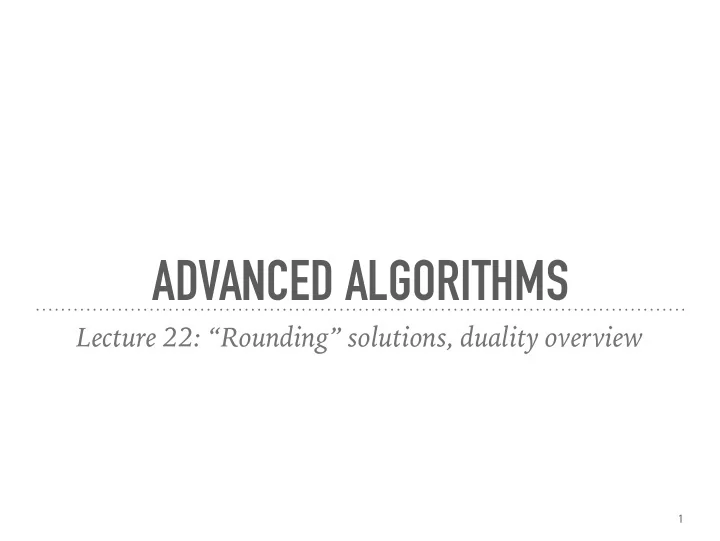

ADVANCED ALGORITHMS Lecture 22: “Rounding” solutions, duality overview � 1
ANNOUNCEMENTS A linear programs next week ➤ HW 5 is out — best 5 out of 6 Hw ➤ Project “mid-way” report due this Friday (or weekend) I submit on canvas one submission only per group � 2
LAST WEEK ➤ Linear programming � 3
IO N k Nn LAST WEEK m it ➤ Geometry of linear programs ii ➤ what is a “corner point”? (intersection of n of the planes) ➤ neighboring corners ➤ simplex algorithm ft ➤ alternate definition of corner point H ➤ LP for combinatorial problems ➤ Matching linear program — all corner points are integral! (proved by two methods) (determinants; characterization of corners) 1 weighted matching � 4
MONITORING EDGES (A.K.A. VERTEX COVER) ➤ Problem. given undirected graph G = (V , E), find a small set of nodes S such that every edge has at least one of its neighbors chosen . end points 1/2 Variables: x i 0 ≤ x i ≤ 1 a na my 2 1 ∀ edges { i , j }, x i + x j ≥ 1 minimize ∑ x i 1/2 1/2 I i Optimum value of the LP can be smaller than “real” opt value … e Note that it can’t be larger! Because any integer solution is also feasible for the LP � 5
“ROUNDING” SOLUTION denotes the optimum value of the If Theorem OPTy denotes the value of the optimum 0 1 LP and P Tuc PT then Solution OPT OP Tu Z L En op Tu 3 PT I fractional sdn ni a Proof rounding By so that the objective 0 1 solution to one are not too different values � 6
satish IV edges g n with come up with Start ni some i Yi C o I sety.ir 5 fifnido set Yi L 0.5 if ni 3 then is yityj 71 If 31 nitaj what happens to objective value Can wereeak Eti E Yi R Yi E 2mi For energi E 2 xi yi to
APPROXIMATION ALGORITHM efficient poly time algorithm F whated an whose cost is solution yi that a produces OP 2 E OPT Tue I up dound paradigm Relax and integral fractional writidg a discrete OPI mone lo continuous opt � 7
OTHER PROBLEMS — INDEPENDENT SET ➤ Problem. given undirected graph G = (V , E), find the largest possible set of nodes S such that has no edges within. kntown poly time There is no n algorithm that has an n 7 approx ratio even 0 1 variables Ni i nj El i j H edges ni � 8
LIMITATIONS me 2 Xi max El i j nj ai H edges b t OPT 12 � 9
SUMMARY SO FAR ➤ LP (“continuous”) formulations for discrete problems ➤ can get lucky — all corners are integral (i.e., discrete) ➤ corners can be “somewhat integral” — approximation algorithms ➤ corners can be totally useless — better LP? TFheduling clustering � 10
PROBABILISTIC ROUNDING ➤ Example. consider “hiring problem”; given n people, each having expertise on a subset of m skills, hire k people in order to maximize total number of distinct skills. iii h Ein covered if o0bs is skill j j at least one of the i's that O are enperts in skill jinosen � 11
FORMULATING THE LP a boolean van that is I supposed to be Zg ai covered and 0 otherwise skill j if E 31 covered ni is Skill j ienbrslj I I Zj l tinnnijit k E Ni and 0EZj El Zg E ienbrs j maximize E Zz Objedinfn � 12
relaxing OEnitt Ki C o i variables constraint K ni midlife.si j maximize objective O j
j BAD SOLUTIONS? skills people l 1 a 2 X k 2 1 b o o 2 X 2 integer OPT us ohy ET ta g 5 Id o 4 6 2 but OPTLP e 5 zfo � 13
PROBABILISTIC ROUNDING I Turns out we can compute … Using this, can show that expected # of topics “covered” > 0.63 * OPT � 14
APPROXIMATION FOR MAX-K-COVER � 15
SUMMARY SO FAR ➤ LP (“continuous”) formulations for discrete problems ➤ can get lucky — all corners are integral (i.e., discrete) ➤ corners can be “somewhat integral” — approximation algorithms ➤ Randomized rounding — natural idea, reasonably simple to analyze � 16
Recommend
More recommend